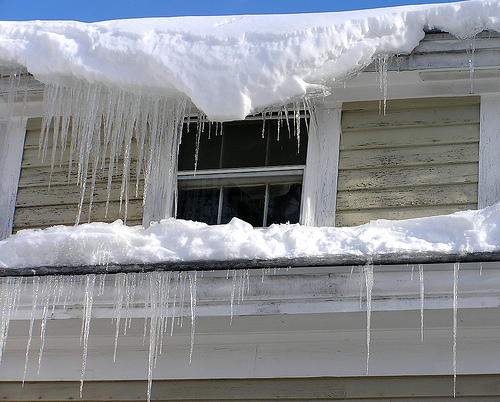12 Ways to Keep the Cold Outside
 Let's be honest, cold weather is great for skiing and pond hockey, but at home it's really just a nuisance. You have all the extra clothing, the snow shoveling, the filthy car, the reminding the kids to please SHUT THE DOOR ad nauseam. Each winter season also brings the challenge of buttoning up the house so you don't have to wear your down parka to bed. To that end, here are a dozen methods that you may not have thought of (perhaps due to the mental confusion of hypothermia).
Let's be honest, cold weather is great for skiing and pond hockey, but at home it's really just a nuisance. You have all the extra clothing, the snow shoveling, the filthy car, the reminding the kids to please SHUT THE DOOR ad nauseam. Each winter season also brings the challenge of buttoning up the house so you don't have to wear your down parka to bed. To that end, here are a dozen methods that you may not have thought of (perhaps due to the mental confusion of hypothermia).
1. Weatherstrip the doors and windows.
Granted, this is the home improvement equivalent of "Eat your vegetables," but it's the best single way to keep the cold outside. This is because airflow moves cold and heat around your home faster than any other means. There are loads of different types of weatherstripping, and it's all affordable. Just use whatever it takes to stop drafts. If you can't properly seal a door threshold, lay down a rolled-up towel or draft-stop.
2. Seal your lid.
In this context, the lid is the ceiling between the living space and the attic. This is where the most heat loss occurs—through air leaks and natural convection (hot air rises, cold air drops). But it's not just the heat loss causing problems: As the warm air escapes, it creates negative pressure that pulls cold air in through air leaks elsewhere in the house. Sealing around light fixtures, plumbing pipes, attic scuttle doors and other penetrations stops air flow through the lid.
3. Insulate your lid.
In conjunction with air sealing, insulation slows the transfer of heat through the ceiling structure, in this case via conduction which contributes to overall heat loss.
4. Air seal everything else.
This includes areas you probably never considered, like electrical outlet and switch boxes, dryer and bathroom vents, plumbing pipes and the framing above foundation walls. Stopping these leaks with caulk or spray foam reduces heat loss (and cold gain) throughout the house.
5. Add storm windows.
While storm windows aren't ideal for every house and budget, they are a relatively inexpensive way to help keep the cold out (relative to new windows, that is). Storms don't appreciably increase the R-value of windows, but they do provide a buffer against cold wind, and they slow the loss of heat through the glass and air gaps in the regular windows.
6. Stop up the chimney.
Chimneys with old fashioned iron dampers suck. Literally. They usher warm air out and cold air in, 24 hours a day. You can effectively seal a fireplace chimney with a quality flue-top damper or a balloon-type plug.
7. Flap your vents.
Vent hoses or ducts for clothes dryers and bath fans should have a flapper-type vent hood at their outside ends. And the flappers should be cleaned periodically so they close all the way. Without the flapper, you've got a 4-inch hole letting cold into the house.
8. Plant a wind break.
In the category of long-term solutions, planting a group of evergreen trees and/or shrubs buffers your house against prevailing winter winds.
9. Use area rugs in living spaces.
Rugs don't warm your house, but they do a nice job of protecting your tootsies from cold floors, especially those over unheated basements, crawlspaces and garages.
10. Cover windows.
At best, windows do a marginal job of keeping the cold outside. Insulated shades and curtains or even homemade insulated panels can help, especially at night. Just remember not to block the light (and solar heat) during the day.
11. Insulate above the basement or crawlspace.
If area rugs (item 9) don't cut it, consider insulating the floor over an unheated basement or crawlspace, creating a simple thermal barrier between your living spaces and the 55-ish-degree air down below.
12. Get an energy audit.
An inexpensive (often subsidized) professional test for air leaks, insulation levels and other thermal performance factors is the best way to learn where the cold is getting into your house.
For help with any of these heat-saving tasks, hire a reliable contractor.
Looking for a Pro? Call us (866) 441-6648

Heating & cooling Average Costs
HVAC Contractors Experiences

The Power Of Multiple HVAC Estimates

A Simple HVAC Repair Stopped Our Air Conditioner Blowing Hot Air



